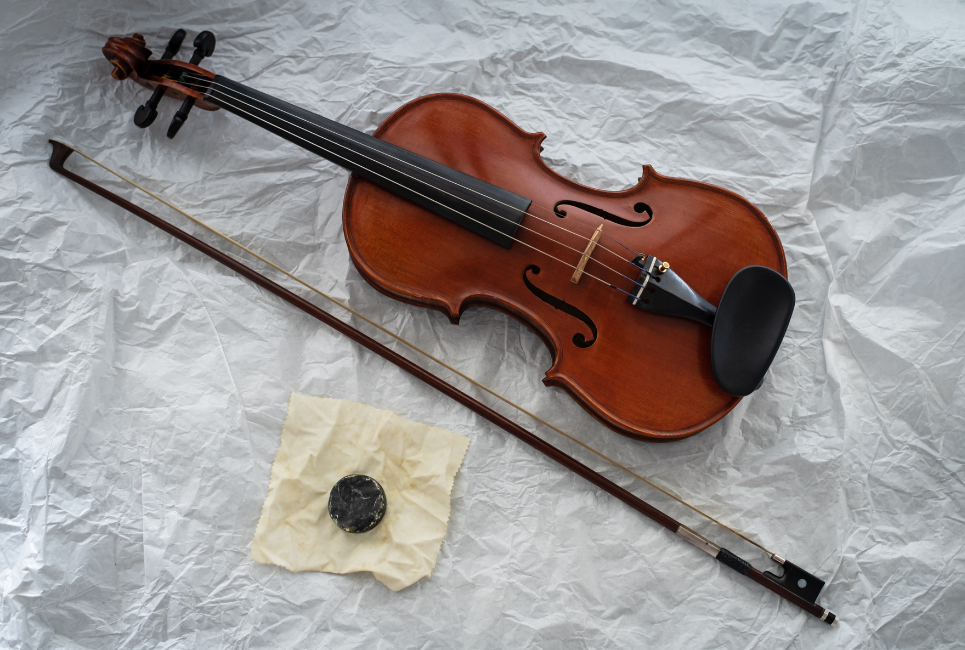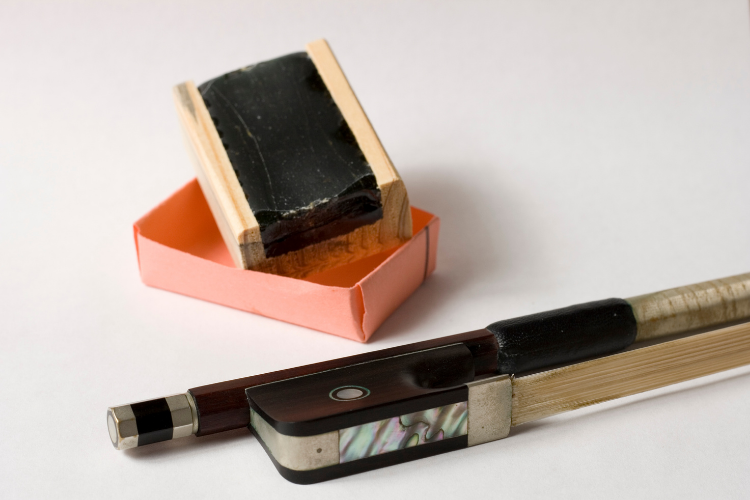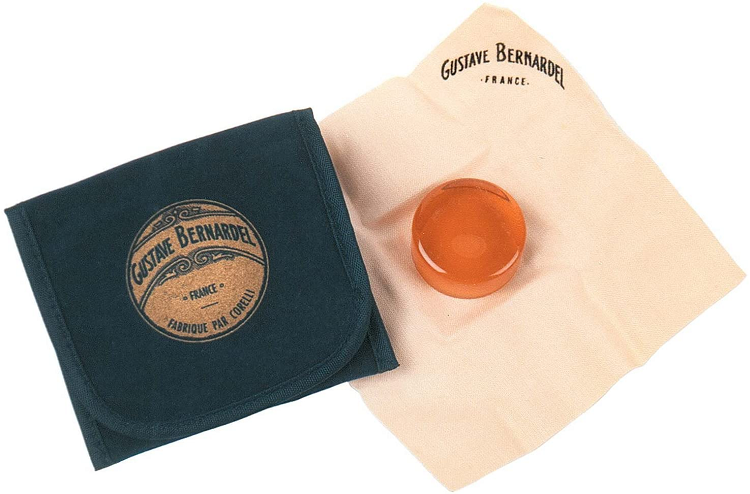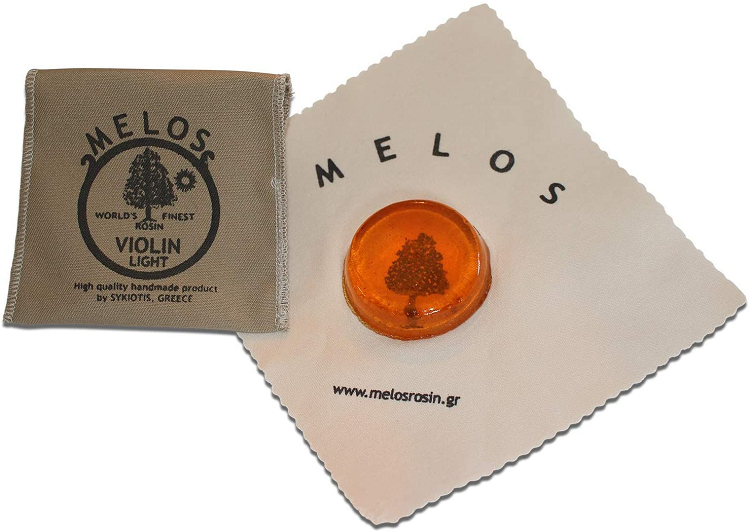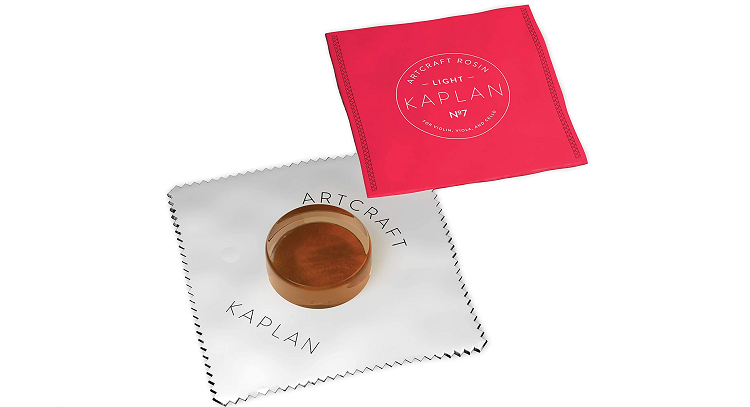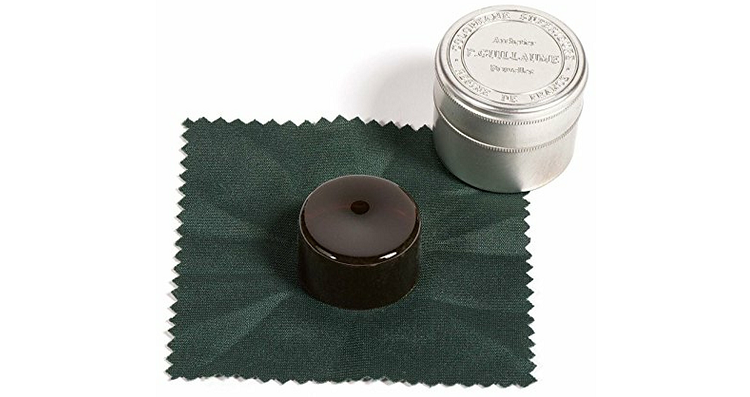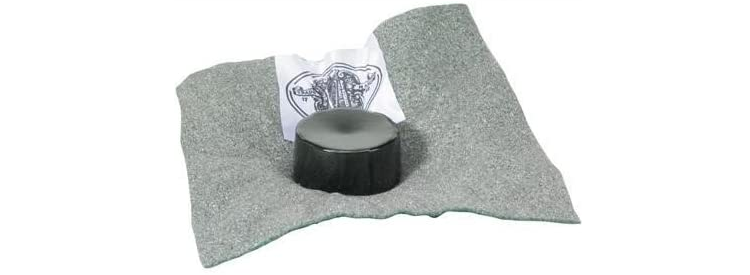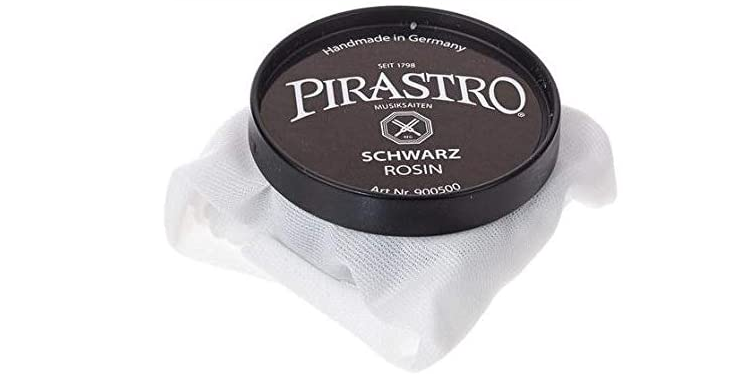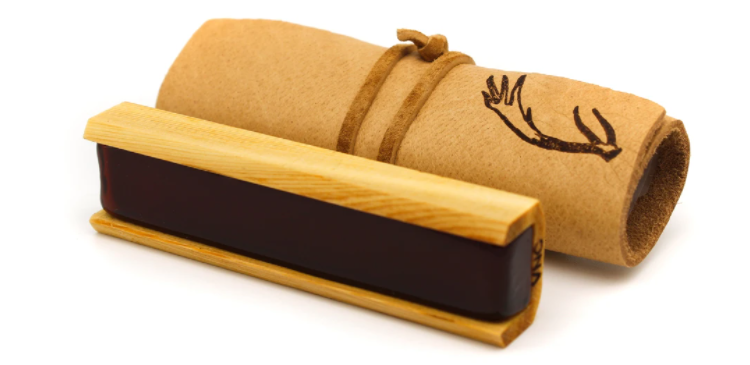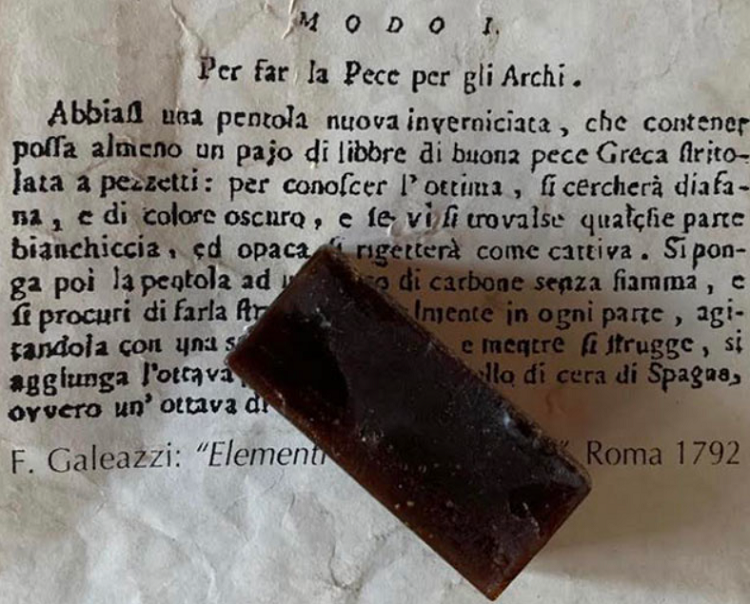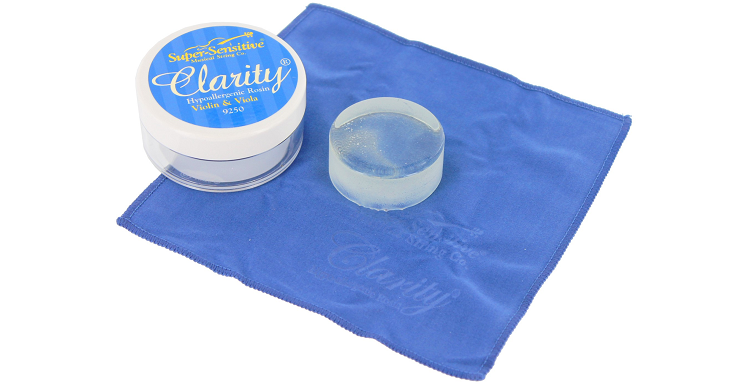- How to Find the Best Violin Shoulder Rest - April 12, 2022
- How to String a Violin – A Guide to Changing Violin Strings - April 3, 2022
- How to Tune a Violin: A Guide to Tuning the Violin - March 21, 2022
As most people reading this know, there’s not much point in drawing a bow across a violin string unless it has a layer of rosin on it. Horsehair and strings alone barely produce a sound! While a lot of attention is (rightfully) given to the quality of bows and their craftsmanship, the importance of this compact, sticky substance is often overlooked.
The friction created permits violinists to perform all kinds of bow techniques. It would be impossible to play a simple down or up bow-stroke parallel to the bridge without rosin, as the bow would slip.
High-quality rosin (and strings) allows the player to work with the violin’s range of tones to a greater extent. Even if you have a cheap instrument and bow, it’s worth investing in good rosin and strings.
What is Rosin?
The primary substance in rosin is the sticky resin from pine trees. The pure resin is often mixed with other substances like essential oils, beeswax, and metal chips (gold, silver or copper) to form the rosin we use for violin playing. Rosin is the name given to solid resin, whatever its final use may be.
The first stage in making rosin is to extract the resin from pine trees. This process is called “tapping” and involves making slight incisions in the bark. Tapping does not harm the trees as they go on to produce resin year after year.
The resin is then completely melted down, at which point secondary substances may be added. The next step is to pour it into the desired mould and let it set. Finally, the hardened rosin is polished, ready to be sold.
So, what Kind of Rosin is the Best for You?
That depends mainly on your bow technique and the material of your strings. Like with many violin accessories, it’s not just a question of price and quality. Some rosins favoured by professional players cost less than $15.
Some high-quality brands may be totally unsuitable for your strings or instrument. You may find that your preferences change over time, as your playing will inevitably do too. Therefore, it’s a good idea to try out different rosins from time to time and take advice from the musicians around you. I discuss the following kinds of rosin in this article:
- Beginner rosin: easy to apply and inexpensive
- Light or dark rosin: good quality products in these two main categories
- Pirastro rosin: made by the great strings manufacturer for different kinds of strings
- Luxury rosin: high-end and customised
- Baroque rosin: designed for period instruments
- Hypoallergenic rosin: alternatives for those allergic to rosin dust or metallic compounds
Best Rosin for Beginner Violinists
It takes a little while to get used to applying rosin to the bow. As rosin can easily splinter into thousands of sharp, sticky pieces if dropped, I suggest that beginners choose practical moulds of rosin with grips on the side.
Remember to lightly scratch the shiny surface of the new rosin before use. But don’t scratch it too hard or deeply, or chunks will break away!
D’addario natural rosin light is a good, affordable option. It has wavy plastic grips on the sides and comes in a cardboard box. At under $4, it’s not such a big deal if it gets lost or broken. The fact that it’s light (and therefore produces less friction) is suitable for beginners, as the tendency is to put too much weight on each bow stroke resulting in a scratchy sound.
Leto 603 rosin is a nice alternative. It comes in a plastic case which is more durable than the D’addario cardboard. Amber in colour, this rosin produces very little dust, which is practical for children who won’t dust off their violin and strings after each practice.
Light or Dark Rosin?
The general rule of thumb is that light or amber rosin should be used for hot and humid climates, as it won’t soften and become overly sticky in the heat. Dark rosin should be used when the weather is cold and dry, as the softness will allow for a warm tone despite the air.
I have spent most of my life playing the violin in cold, rainy climates and have always preferred light, amber-coloured rosins. I used dark rosin for a short while a few years ago and found the friction too intense.
However, that could simply be a question of habit. I know that many fiddle-players prefer dark rosin, which is probably because the genre requires sudden halts together with less continuous pressure in the upper half of the bow.
I Recommend these Light and Amber Rosins
The Original Bernadel Rosin
The Original Bernadel Rosin is a popular choice and a good all-rounder. It’s easy to apply smoothly and evenly across the length of the horsehair and comes in a velvet pouch to stop it from drying out. It produces an average amount of dust and has a medium grip.
Although the rosin is hard, the effect is ‘soft’ – meaning that the sound doesn’t jump out the second you bow on the string. One feels the necessity to work the bow in order to make a rich sound.
Melos Light Violin Rosin
Melos light violin rosin is a much-loved option around the world. Made solely from Greek pine sap, it has a pleasant aroma and is recommended for summer use. There is a Melos dark rosin for winter, but the light variety works very well all year round. The rosin is potent, so a little goes a long way.
Kaplan Artcraft Rosin
Kaplan Artcraft Rosin is what I’m using now, and I find it works well on various strings. I often have different kinds of string on my violin (Obbligato G and D, Passione A and Evah Pirazzi E are my favourites, but I try different combinations), and this inexpensive rosin seems to adapt well to them all.
These are Some Lovely Dark Rosins
Pierre Guillaume Deluxe Rosin
Pierre Guillaume Deluxe Rosin is popular where I live, in Belgium. It’s not the darkest possible violin rosin, more like a burnt caramel colour. It is potent and smooth, so one application will last many hours of violin playing.
W.E. Hill & Sons Dark Violin Rosin
W.E. Hill & Sons Dark Violin Rosin is a widely used and favourite choice. Although it produces a lot of dust, its firm grip gives a smooth and controlled sensation.
Pirastro Rosins for Pirastro Strings
The leading string brand Pirastro has matching rosins for some of their strings. If you buy sets of any relevant Pirastro string, it’s well worth trying out the matching rosin. They also have two general makes: the Schwarz dark rosin designed for steel strings and the Goldflex light rosin mixed with golden metal powder, for a particularly warm sound.
I tried the Obbligato rosin as I had the matching G and D strings on my violin. It made them vibrate beautifully but caused the Passione (gut) A and E strings to squeak, as the rosin is specifically designed for synthetic strings.
It might well be the case that a particular kind of Pirastro rosin works for your non-matching string. My friend uses the Pirastro Oliv rosin (designed for Evah Pirazzi strings) with his Pirastro Tonica strings and finds that it works very well.
Tips for Finding a Suitable Rosin
- Start with a standard, light or amber rosin. If the sound seems too bright or harsh, try a darker rosin
- If you feel there’s not enough friction, or you want more control in the bow, try a more potent rosin
- If your rosin is making your high strings squeak, try a lighter one
- If the sound is too gritty or deep, try a harder one
- If you’re using a beginner’s rosin and are unhappy with it, try a better quality one
- When you buy your strings, ask what kind of rosin best matches them
- Don’t over-apply rosin. Too much of it will produce an unpleasant sound
- Make sure you’re bow is sufficiently rosined every time you play
Special Rosins
Luxury Rosin
Leatherwood Bespoke Rosin offers customised blends, depending on what kind of instrument you have and what sort of music you play. One can choose percentages of their two main blends, ‘crisp’ and ‘supple’.
The crisp blend enhances clarity and articulation, while the supple blend intensifies the deep, warm timbres in the sound. For €65.00, you can buy a rosin that is 75% crisp and 25% supple, for instance. The rosin comes in a timber casing and lasts for up to 5 years.
Bogaro & Clemente is a luxury Italian brand selling string accessories. They have a wide range of rosins (light, amber and dark) in unique shapes and beautiful wooden boxes. Given the one-of-a-kind design, these rosins would make an excellent present for a violinist friend.
Rosin for Baroque Bows and Gut Strings
Aquila Historical Rosin is made using a secret 18th recipe and is popular among baroque players who use period instruments and bows. Like with any other kind of rosin, it’s subjective: you don’t have to use historical rosin just because you use gut strings, but you may find it works for you.
I know a baroque violinist who prefers very old, dry, light rosin. Anything new and therefore sticky makes her strings squeak.
Hypoallergenic Rosin
Jade Hypoallergenic Rosin is a good option if you are allergic to rosin dust. It does not contain pine resin or any metallic compounds but still provides a good grip.
However, there are several bad reviews for this rosin, and many players are unhappy with hypoallergenic alternatives such as Super Sensitive Clarity and Geipel. It seems that certain qualities that pine resin has are difficult to reproduce synthetically.
How to Care for Your Rosin
- Always keep it in its cloth or box to prevent it from drying out
- Keep the rosin box securely within the violin case’s pocket
- Try not to touch it too much by holding the cloth/container when applying it
- Scratch the surface lightly when it’s new to allow the rosin dust to transfer to your bow
- Don’t try to create a groove in the rosin. Rub it in different directions to keep it fresh for more time
Protecting Your Violin and Bow from Rosin Residue
You must wipe away the rosin residue every time you finish playing. You can do this with a soft cloth. Focus on the area between the bridge and the fingerboard, which collects the most dust. Then gently pull the cloth under the strings and wipe the fingerboard clean too.
Finally, press the strings down with one hand (to avoid a terrible shrieking noise) and wipe the rosin off the bottom of the strings. You should regularly clean the bow stick, the small space under the bridge, and the wood under the tailpiece. However, this doesn’t have to be done each time you play.
How Rosin Works, Precisely
It’s widely understood that rosin works by forming a ‘layer’ between the strings and the horsehair. Interestingly, this isn’t the case! Instead, rosin clings to microscopic hairs that branch outwards from the long white hairs we see. When you’re bowing, these tiny, rosin-covered hairs brush backwards and forwards between the smooth string and principle hairs.
Rosin particles alone do not do very much. It’s the fusion of rosin and horsehair in motion that creates the magic. For this reason, an excess of rosin on the strings themselves is pointless.
As the microscopic brushing hairs break easily, it’s essential to re-hair your bow every few months. Many violinists believe that one must re-hair the bow when the long white hairs start to fall out, but if you’re playing regularly and the long hairs are intact, you should re-hair anyway for the quality of contact between hair, rosin and string.
What to Do if Your Rosin Breaks
Many players fix broken shards of rosin by putting them together in a small container and re-melting them in the oven. Here is a demonstration:
Personally, I use whichever shard is biggest for a while and then buy new rosin. But I don’t use expensive brands and live in a big city with lots of music shops, so it’s easy.
FAQs
Answer: More rosin is necessary at the heel and tip of the bow. When you apply the rosin, begin at the heel and make several rubs of a few cm before gliding the rosin along to the tip of the bow. Rub similarly at the tip, and finish with a few gentle, long glides along the entire length.
Answer: The simple answer is: until you feel its effect is wearing off. Rosin hardens over time, so if you use soft, dark rosin, you will probably notice a difference within a year or so. If you use light rosins which are naturally hard, you might not notice anything, and that’s fine! Some violinists prefer very old rosin because they only want minimal friction.
Answer: No, although it’s not good for them either. Cats and dogs may be attracted to your rosin (or rosined bow) because of the smell of bark. It’s best to keep your rosin tidied away in your violin case, but if they do lick or eat a bit of it, there’s no need to panic.
Answer: It depends how much time you spend playing the violin and how potent your rosin is. I use hard amber rosin and generally apply a small amount for every half-day of playing. So, if I’m in a full-day orchestra rehearsal, I’ll apply rosin twice. If I only practice for two hours on Monday, I won’t re-apply rosin on Tuesday.
Answer: Too much rosin distorts the sound of the violin. It will seem harsher and grittier than usual. Much too much rosin will produce white dust in the air around the contact point of the bow and strings.
After you’ve applied rosin, you can make some fast, whipping gestures (carefully!) to remove any excess dust before you start playing.
Answer: Even if you wipe your violin consistently after playing, some rosin dust will seep into the violin’s varnish. This can be treated by a violin-maker, who will clean your violin’s surface with special products. Most professional violinists visit a violin-maker at least once a year to have their instrument checked up on and cleaned.
Answer: Most rosin brands make different products for the violin, viola, cello and double bass. The larger the instrument, the more friction is necessary between bow and string. That said, most violin rosins will work well on viola bows.
There are hundreds of lesser-known bowed string instruments that will all require rosin. If you play one of the many kinds of lyra or traditional Chinese instruments, it’s worth contacting a specialist to ask what kind of rosin is the most suitable.
Answer: Like for violin bows, rosin is used to create friction in several artistic fields. Ballet dancers are known to rub rosin on the soles of their shoes to prevent them from slipping. Gymnasts and other athletes rub it on their equipment and gloves to improve their grip.
Rosin is present in a wide range of varnishes and glues, soaps, paper and wax.
Final Word
Finding suitable rosin takes a while and might only feel ‘right’ in certain conditions. Your rosin may match perfectly with a set of strings but not work so well if you change string type.
Some violinists have different rosins for different bows and instruments. Even if you’re pleased with your rosin, don’t hesitate to try others from time to time. Most players would be happy to let you apply their rosin to your bow!
Looking for more interesting readings? Check out:

